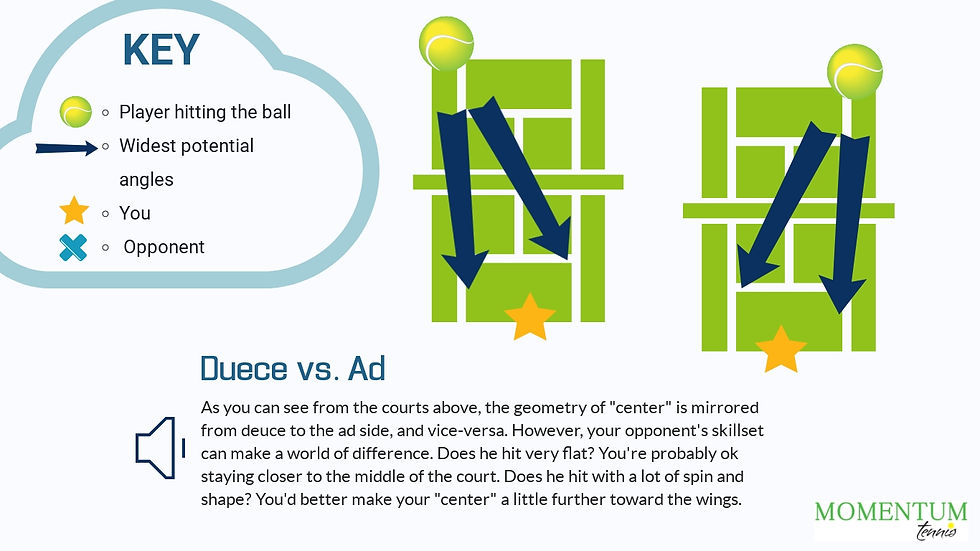The One Thing Every Great Player Does, but Nobody Ever Taught You - Part 1
- Ryan at Momentum Tennis

- Feb 20, 2019
- 3 min read
Updated: Feb 21, 2019
What's the most obvious difference between pro tennis players and rec players?
Is it accuracy? Consistency? Racquet head speed? Mental strength? You could make a case for any of these. But there's one thing every professional is doing which many rec players don't do at all...
Moving off the ball and getting to center point.
While Federer is gliding towards the ad side to create a forehand opportunity for himself, Joe Rec is stationary, watching his opponent hit the ball. And because Joe Rec was passive instead of proactive with his court positioning, he's forced to play a high backhand--his weakness--on the next shot. Meanwhile, Federer gets to hit his best stroke (forehand) from his most lethal position (ad side, inside the baseline).

Now, anyone who's spent a decent amount of time on a tennis court knows that they probably shouldn't be standing and watching their opponent hit the ball. Just about every coach will get on you for loafing around during a point--it's just not a good look.
***I once told a particularly movement-averse young student that if he wanted a technically challenging sport where he didn't need to move, he should take up golf. Funny thing is, he did! I wasn't upset...only shocked that he'd finally decided to heed his coach's advice.***
Okay, so you know that you need to move off the ball, even when the ball isn't on it's way to you. Just get back to the middle and you'll be fine, right? Not quite.
Don't Recover to the Middle
The big mistake many players make is recovering to the exact middle of the court. They hit the ball, run to the center hash mark on the baseline, and wait to see where the next ball will take them.
The problem with this strategy is that the exact middle of the court is almost never the best place to recover to! Unless of course you enjoy being late to balls, defending instead of dictating points, and having winners fly by you untouched.
If, on the other hand, you want to take time away from your opponents, hit your favorite shots more often, and win more matches...here's what needs to happen:
You need to learn
1) Where to go, when to go there, and why.
2) How to make recovering to your center point second-nature.
Good news--we've got you covered. Below are three illustrations explaining the basics of singles positioning and center point, followed by some practical exercises for turning your new knowledge into your new skillset.
Where Should You Go?
Instead of recovering to the exact middle of the court, recover to the middle of your opponent's widest hypothetical angles. The idea is to station yourself at the midpoint between the widest two shots you could reasonably expect your opponent to hit.

When you recover to your center point, everything suddenly becomes so much easier--many players even note an inherent mindset change. Instead of being reactive and defensive, you're free to be proactive and dictate points. Instead of your first step leading you to chase the ball, it can lead you to intercept it, which increases your shot options and takes time away from your opponent. I could go on...
Suffice it to say, recovering to center is game-changing due to it's ability to affect both players' tactics, stroke-production, and confidence.
Where You Hit Determines Where Your Center Point Is
Once you start imagining where your opponent's two widest potential angles are, you'll soon realize that you have direct control over where your next center point will be. Your future center point is directly related to where you hit the ball.

Still, there are many variables to consider when identifying your center point, such as:
your opponent's skillset
your skillset
the height of your opponent's contact point
the depth of your opponent's contact point
Did your opponent decide to let the ball push her deep back behind the baseline, or did she step in and take it on the rise?
Or did she really change the dynamic of the point and come to net?
***This post is continued in Part 2. If you want to learn specific exercises to practice center point and make it second-nature, stay tuned.***



Comments